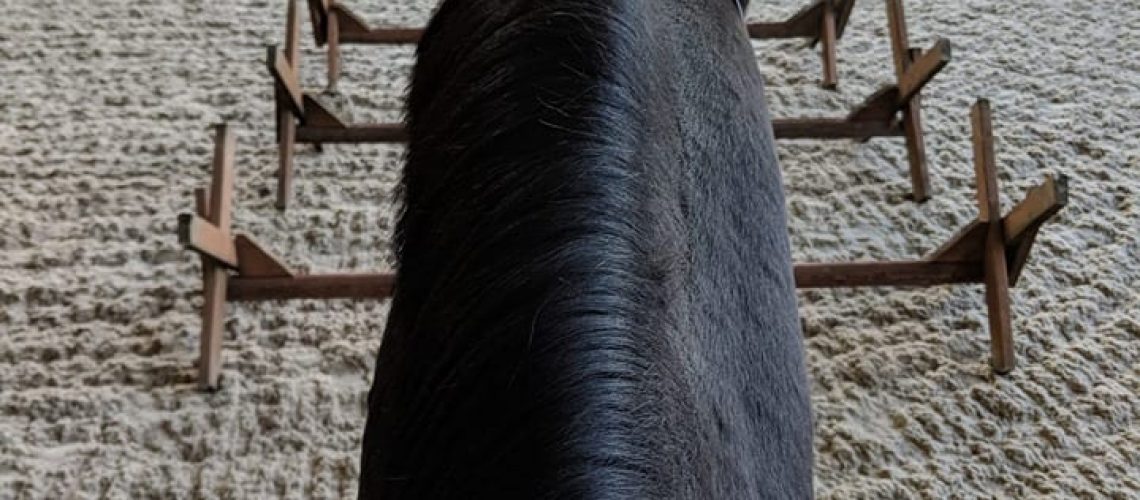What is Cavaletti work?
According to Wikipedia, “Cavaletti were invented by Federico Caprilli and designed to help a horse improve its balance, adjust its length of stride, and to loosen and strengthen its muscles.”
This is a neatly concise and accurate definition of the benefits of using cavaletti in a horse’s training and conditioning program. Cavaletti require the horse to look where it’s going, place its feet intentionally, lift its legs actively, push off the ground with a little more effort, and balance itself more carefully. In doing these things, the horse uses its muscles slightly differently and with a little (or a lot) more intensity than it would do on its own, which is why cavaletti work is so powerful at building strength and balance.
What are cavaletti?
“Cavaletti” is Italian for “little horse”. They are essentially small jumps, intended for the horse to step over rather than leap over. However, in practice, cavaletti can be anything from the traditional X-style standards with a pole attached that can be set at various heights, to simply poles on the ground spaced with careful consideration of the gait and length of stride for the individual horse.
Proper spacing is key for making the work over cavaletti effective and confidence building. Improper spacing and injudicious use of the cavaletti can make a horse fearful and tense rather than relaxed and strong. Cavaletti set of for walking, for example, will be quite a bit closer together than for trotting. And canter cavaletti must be set to acommodate the horse’s stride in canter. A good way to measure correct distances for your horse would be to take your horse into a freshly raked arena and walk, trot and/or canter in the fresh dirt. Then get off and measure between the horse’s hoof prints. That will give you the correct distances to set the cavaletti for each gait for normal cavaletti use. You can then adjust them shorter or longer, depending on your horse’s fitness level and if you wish to use them to affect the length of your horse’s strides.
You can save effort measuring, if at the same time you are measuring your horse’s strides, you measure your own average stride in the same manner. Then, figure out how many of your average strides makes up one of your horse’s strides in all 3 gaits. Then, no matter where you are, you can use your own stride to ensure you have the proper distance for your horse.
Introduce your horse to cavaletti slowly. Many horses are initially suspicious of stepping over a raised pole. Building their confidence from the beginning will save you a great deal of future grief, so it is well worth taking the time. Start by asking your horse to walk over only one cavaletti at a time. Once your horse is confident walking over the single cavaletti you can take one of two approaches: *either* increase the speed, *or* increase the number of cavaletti. If you plan on trotting over your cavaletti, then try walking and trotting over a single cavaletti at first. Only when your horse is totally comfortable doing both should you then add a second, and later a third.
Until your horse has been successfully negotiating cavaletti with confidence and ease, it is advisable to use no more than 3 cavaletti at a time. Three in a row is enough to present a challenge to your horse’s balance, but is also few enough that if he loses his balance, he an catch himself without tripping. Once three feels too easy, then add a fourth, fifth, sixth, and so on.
Dropping cavaletti or poles in random places around the arena and then doing a normal training ride is also an excellent way to challenge your horse in his normal work. As you ask him to do his normal program, he will also be having to pay attention to where he puts his feet, and make slightly bigger efforts with steps and balance at random times. This is a great way to add variety to your arena work.
There are some really great books about using cavaletti for conditioning your sport horse. My favorites are the books written by Reiner and Ingrid Klimke, which are available on Amazon.com. Ingrid Klimke is one of the top 3 Day Event riders in the world, and cavaletti training is such an integral part of her training program that she travels around the world teaching clinics just on using cavaletti to riders of all disciplines.
Cavaletti work is fun, interesting, and highly effective in developing strong, sound sport horses. Give it a try. You might find it addicting!

